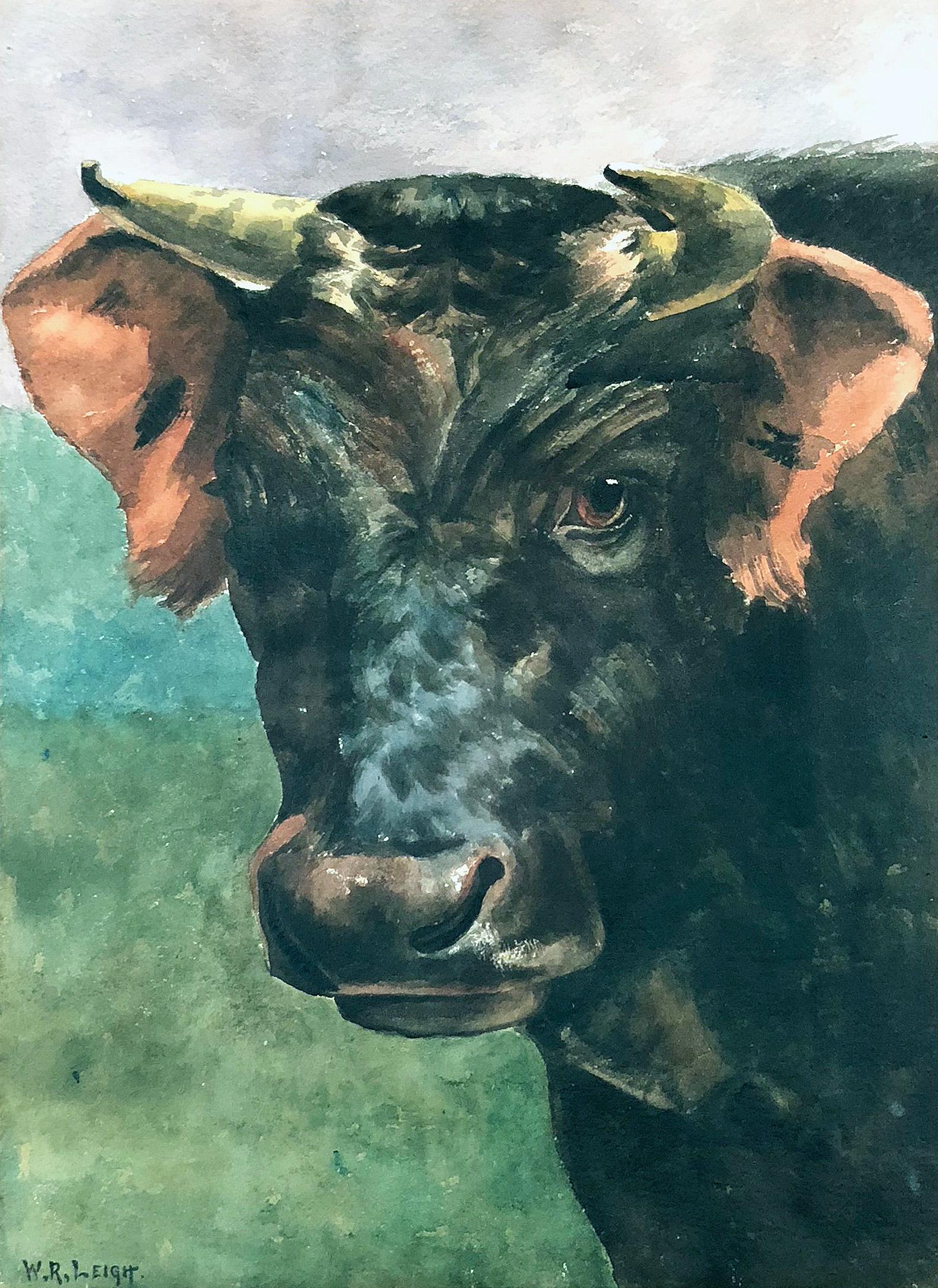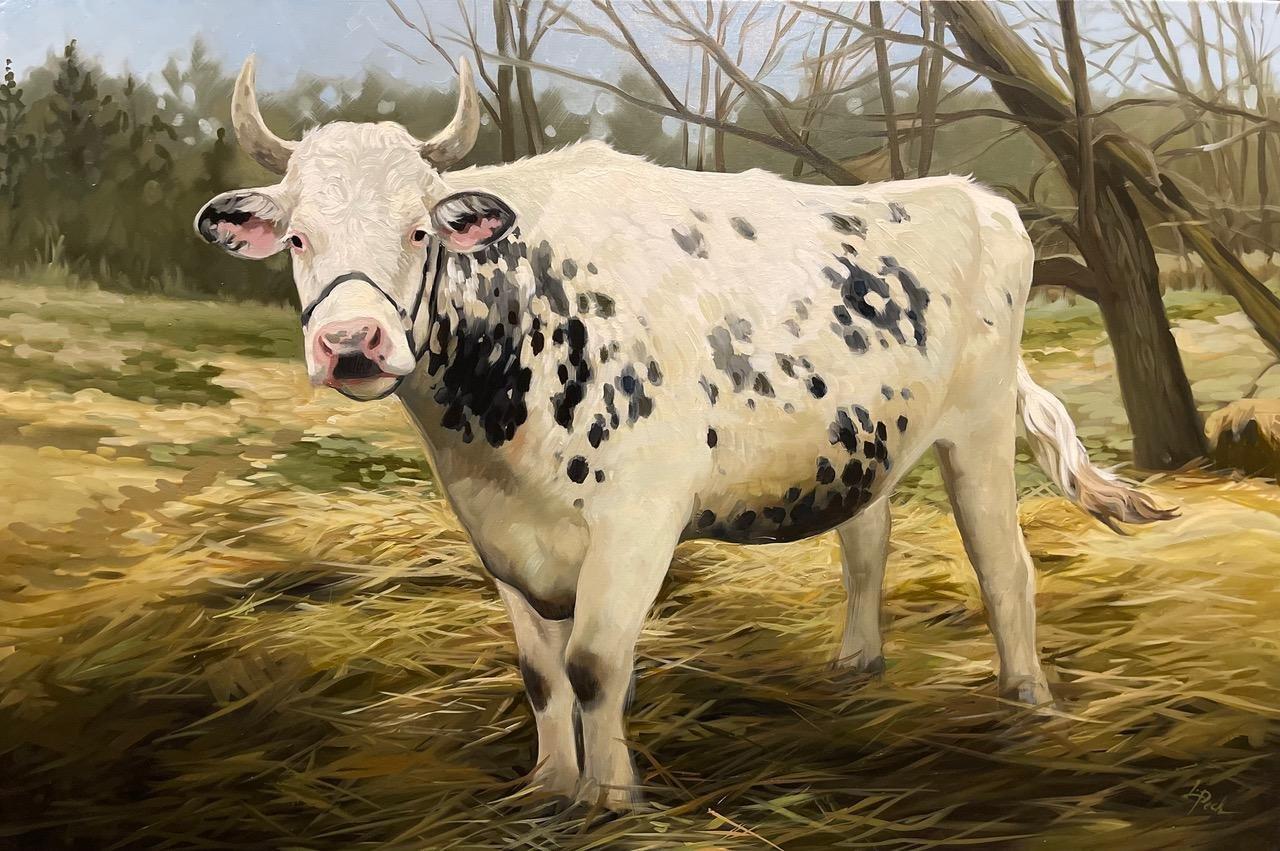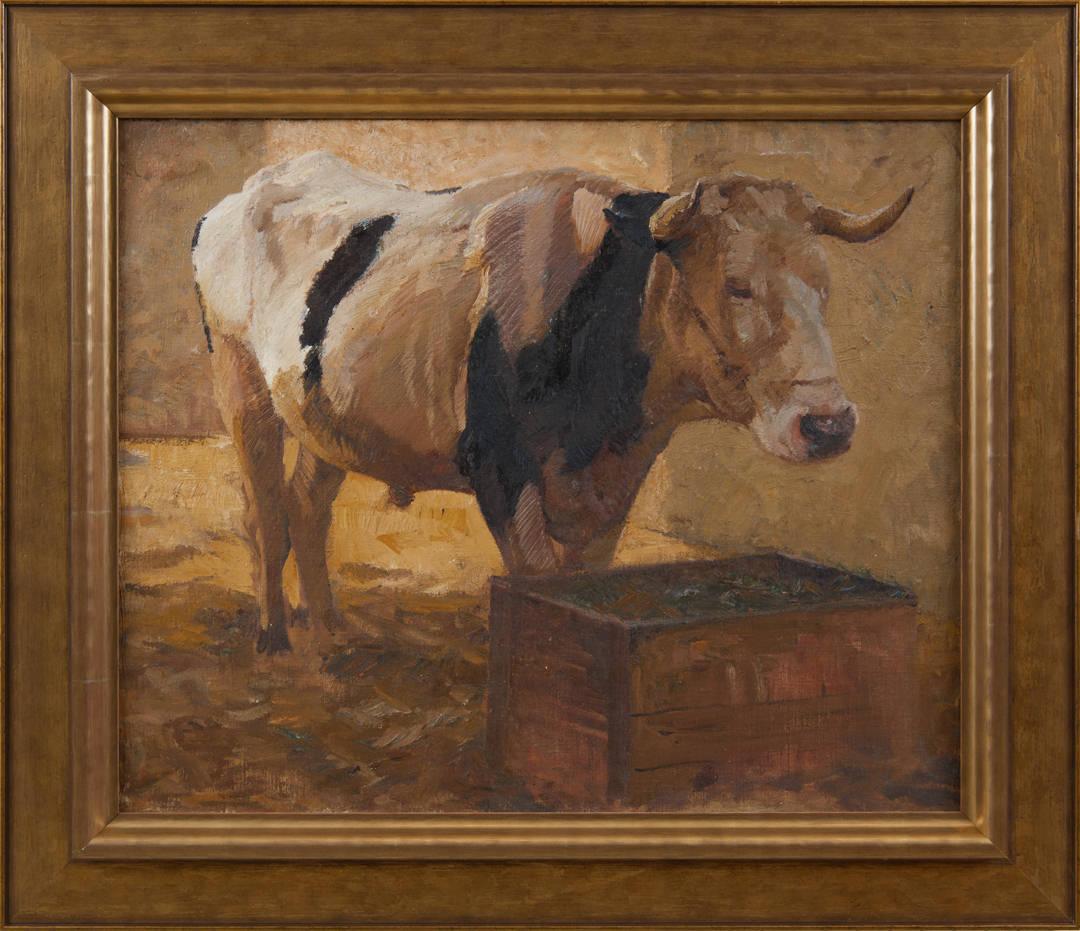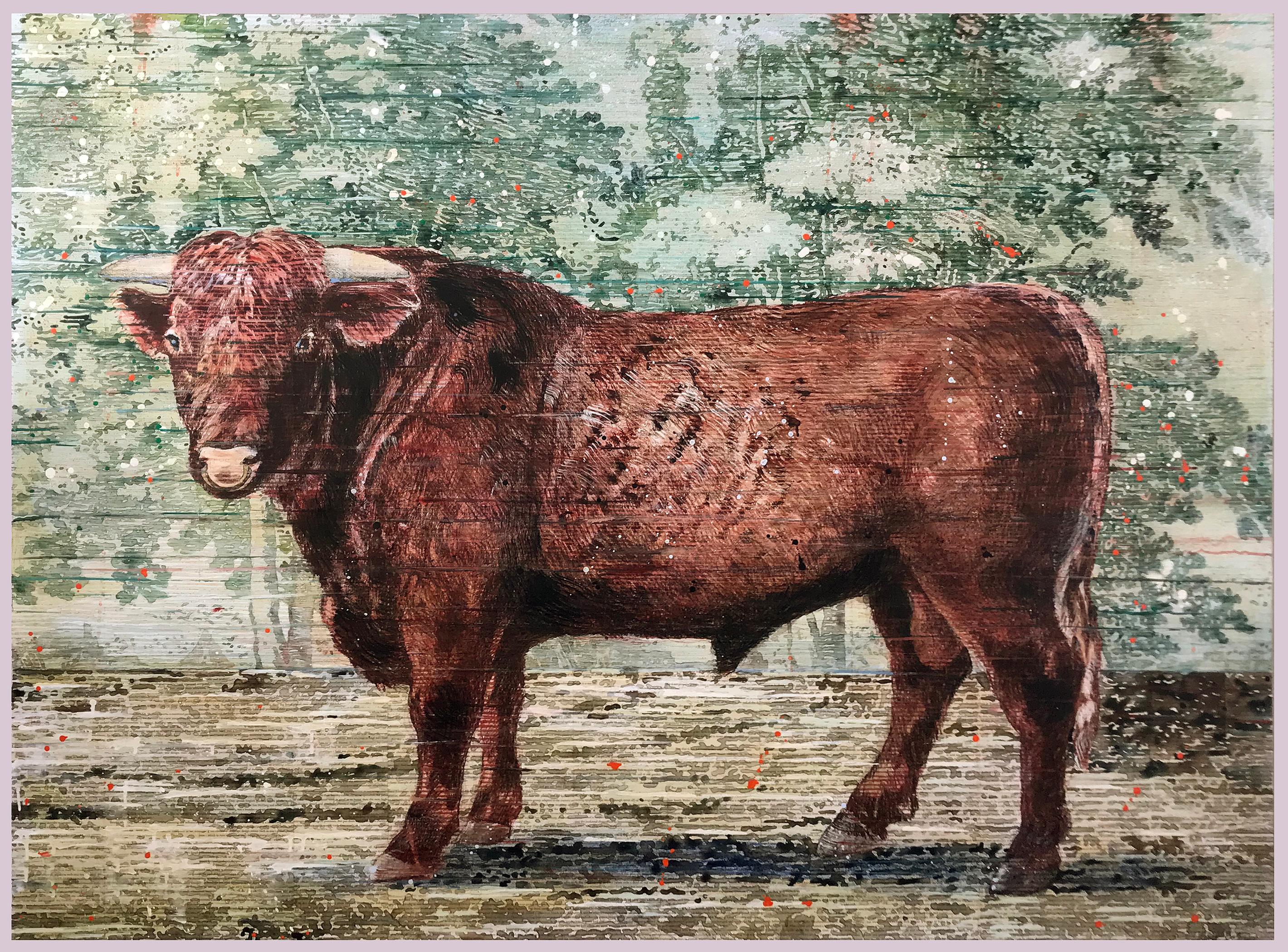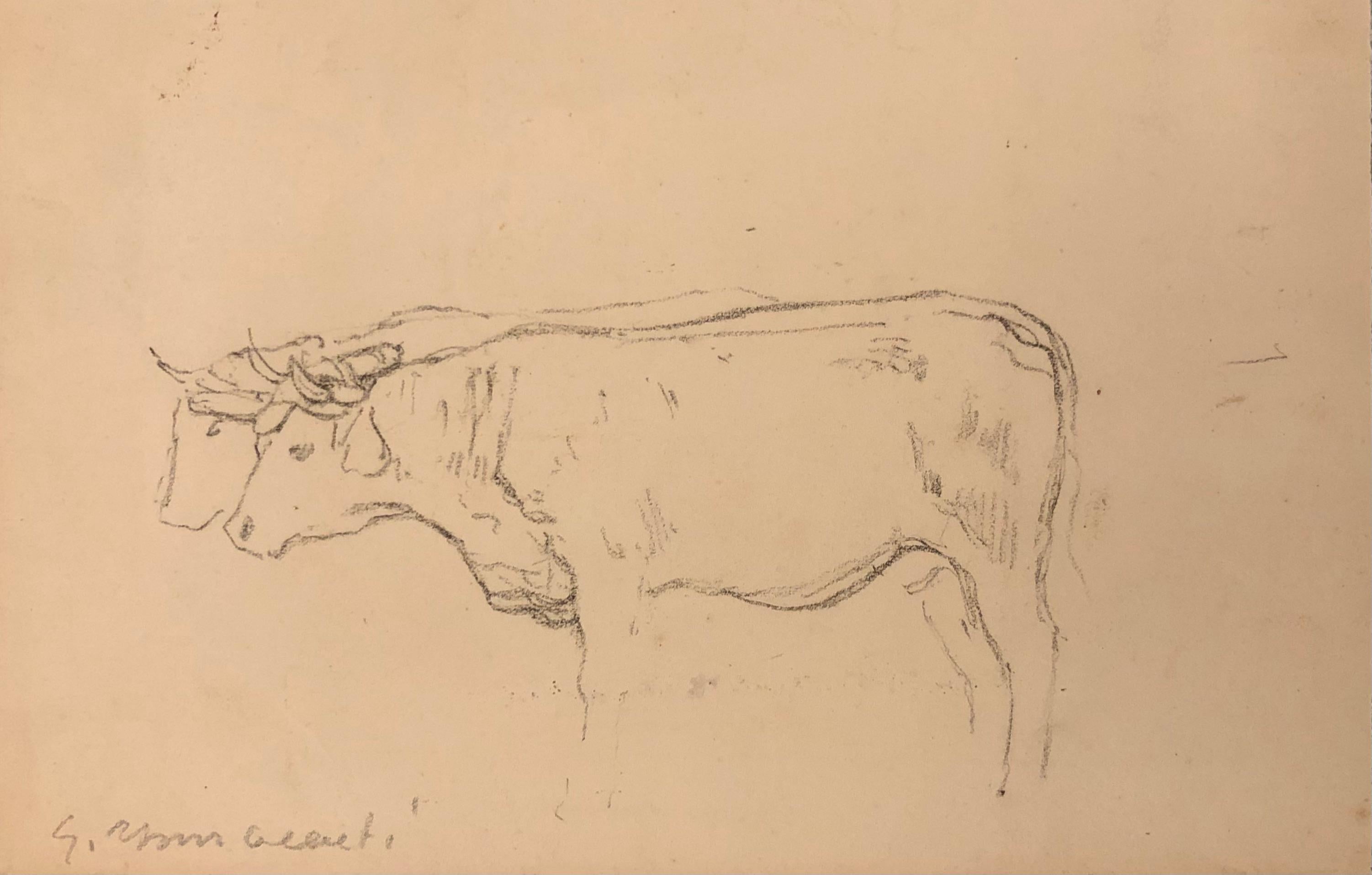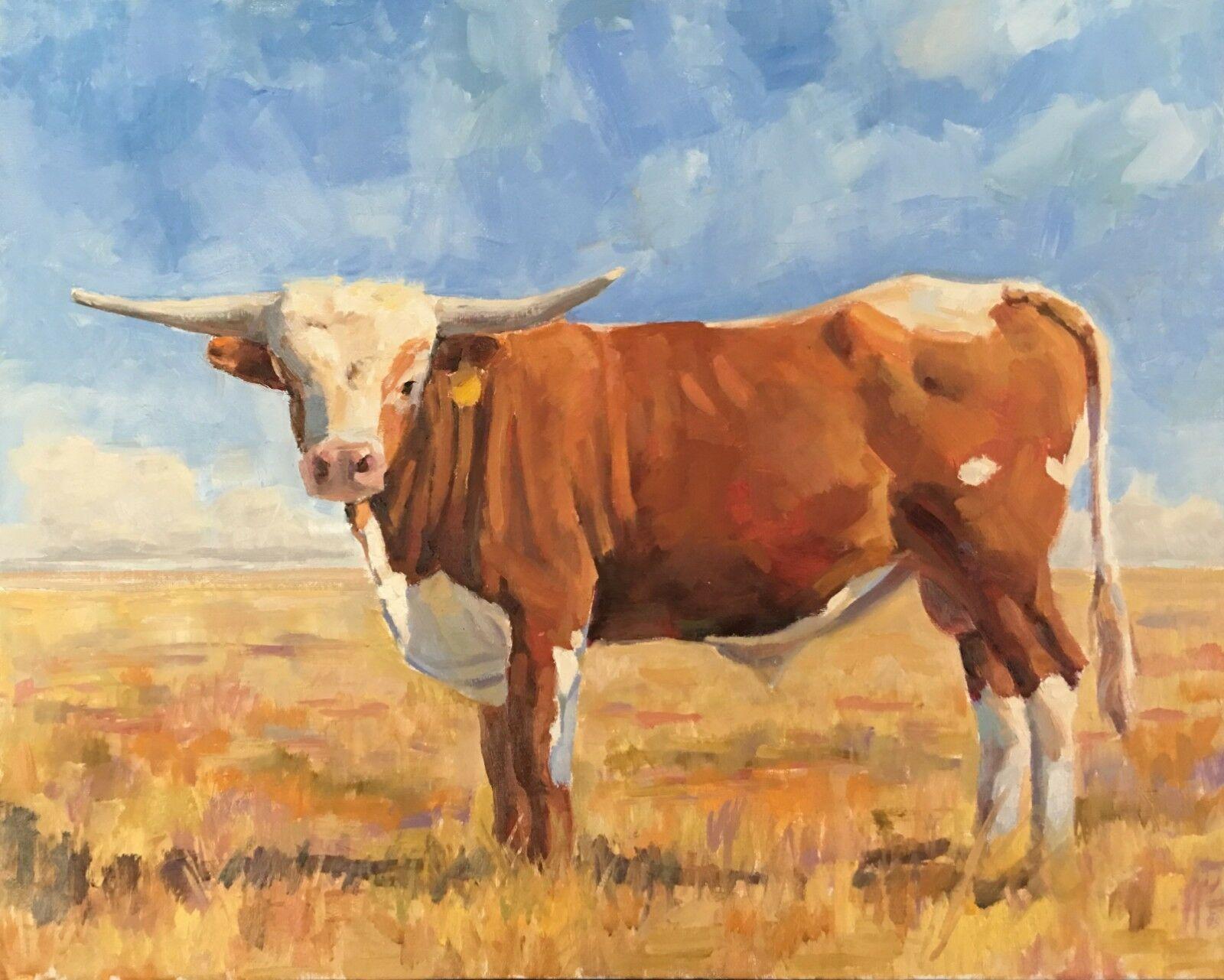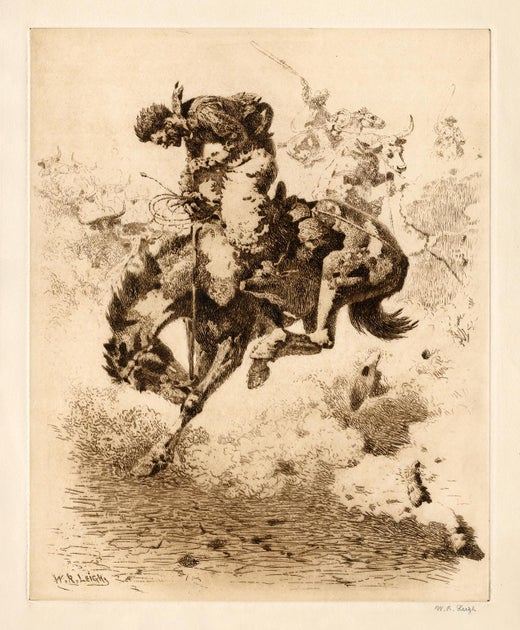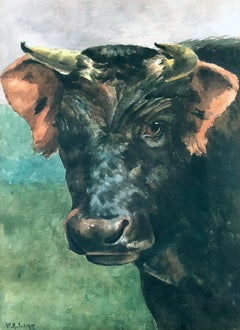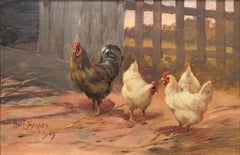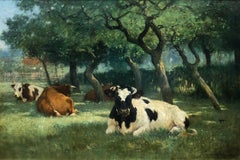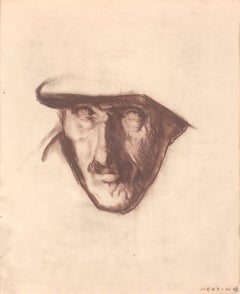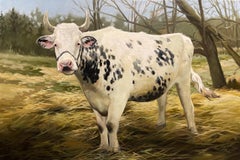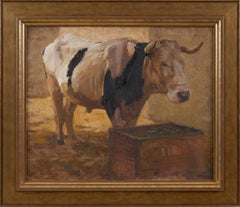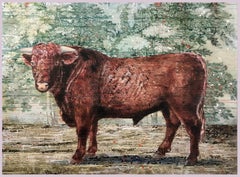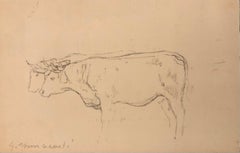Items Similar to Bull
Want more images or videos?
Request additional images or videos from the seller
1 of 11
William Robinson LeighBullUnknown
Unknown
Price Upon Request
Price Upon Request
Price Upon Request
Price Upon Request
Price Upon Request
Price Upon Request
Price Upon Request
Price Upon Request
Price Upon Request
Price Upon Request
Shipping
Retrieving quote...The 1stDibs Promise:
Authenticity Guarantee,
Money-Back Guarantee,
24-Hour Cancellation
About the Item
Bull by W. R. Leigh (1866-1955)
Signed Lower Left
Unframed: 20" x 16"
Framed: 33.25" x 27.25"
Born near Falling Waters, West Virginia on a plantation a year after the Civil War, and raised in Baltimore, William Leigh became one of the foremost painters of the American West with a career of seventy-five years. Some people referred to him as the "Sagebrush Rembrandt".
He was the son of impoverished Southern aristocrats and took his first art training at age 14 from Hugh Newell (1830-1915) at the Maryland Institute where he was regarded as one of the best students in his class. From 1883 to 1895, he studied in Europe, mainly at the Royal Academy in Munich with Ludwig Loefftz. From 1891 to 1896, he painted six cycloramas or murals in the round, a giant German panorama.
In 1896, he began working as a magazine illustrator in New York City for Scribner's and Collier's Weekly Magazine, and he also painted portraits, landscapes, and genre scenes. However, he was not a very successful artist in those years in New York.
Trips to the Southwest began in 1906 when he made an agreement with William Simpson, Santa Fe Railway advertising manager, to paint the Grand Canyon in exchange for free transportation West. In 1907, he completed his Grand Canyon painting, which led to many more commissions and an extensive painting trip through Arizona and New Mexico. These travels inspired him to paint western subjects for the next 50 years, but it was not until the 1940s that he received much recognition. He painted in the Southwest nearly every summer between 1912 and 1926 and focused on the Hopi and Navajo Indians.
In 1910, he traveled to Wyoming, where he painted in Yellowstone Park and did sketches, many which he later converted into large canvases such as Lower Falls of the Yellowstone (1915) and Grand Canyon of the Yellowstone (1911).
His style was realistic, and his palette invariably had the Southwestern hues of soft pinks, reds, yellows and purples. In fact, his critics who knew little of the Southwest accused him of fabricating the colors.
As an older man he was described as a big, powerful man with gray hair and a white handlebar mustache and a deep base voice. He was highly opinionated and absolutely hated modern, abstract art. During the latter part of his career, he painted a series of American historical murals as well as paintings based on his travels to Africa funded by the Eastman Kodak Company and the American Museum of Natural History in New York. For many years, his work was handled exclusively in New York at the Grand Central Art Galleries at the Biltmore Hotel.
Many of his works are at the Gilcrease Museum in Tulsa, Oklahoma. In March, 1999, the Historical Center of Cody, Wyoming held an exhibition of his field sketches and finished works depicting his experiences near Cody, Wyoming in the early part of the century, between 1910 and 1921. These years, many which he spent painting in the Carter Mountain vicinity, were considered crucial to his artistic development because he was exposed to western landscape. His companion during these travels was Cody taxidermist Will Richard who stirred his interest in wildlife.
- Creator:William Robinson Leigh (1866 - 1955, American)
- Creation Year:Unknown
- Dimensions:Height: 20 in (50.8 cm)Width: 16 in (40.64 cm)
- Medium:
- Movement & Style:
- Period:
- Condition:
- Gallery Location:Missouri, MO
- Reference Number:1stDibs: LU747310363112
William Robinson Leigh
William R. Leigh was born in Berkeley County, West Virginia in 1866 and spent his boyhood on a farm. At the age of fourteen he was sent to the Maryland Institute in Baltimore to begin his art training. Although from a very poor family, he managed to spend twelve years in Europe where he studied at the Royal Academy in Munich, Germany. Upon returning to the United States he opened a studio in New York and did illustrations for "Scribner's Magazine". It was not until he was forty years old that he was able to see the West which had occupied his thoughts for such a long time. His bold use of color depicted the clear light and brilliant hues of the West as he saw it. It was during this phase of his career that he came to be known as the "Sagebrush Rembrandt". In 1921 Leigh married Ethel Traphagen, a women's clothing designer, and together they established the successful Traphagen School of Fashion in New York City. In 1926 and 1928 he made two trips to Africa. On these trips he did many paintings of big game, and returning to New York he did the backgrounds for animal habitat groups. He painted in the Southwest nearly every summer between 1912 and 1926. His style was realistic and his palette invariably had the Southwestern hues of soft pinks, reds, yellows and purples. In fact, his critics who knew little of the Southwest accused him of fabricating the colors. He died in 1955.
About the Seller
5.0
Vetted Professional Seller
Every seller passes strict standards for authenticity and reliability
Established in 1970
1stDibs seller since 2017
155 sales on 1stDibs
Typical response time: 14 hours
- ShippingRetrieving quote...Shipping from: Missouri, MO
- Return Policy
Authenticity Guarantee
In the unlikely event there’s an issue with an item’s authenticity, contact us within 1 year for a full refund. DetailsMoney-Back Guarantee
If your item is not as described, is damaged in transit, or does not arrive, contact us within 7 days for a full refund. Details24-Hour Cancellation
You have a 24-hour grace period in which to reconsider your purchase, with no questions asked.Vetted Professional Sellers
Our world-class sellers must adhere to strict standards for service and quality, maintaining the integrity of our listings.Price-Match Guarantee
If you find that a seller listed the same item for a lower price elsewhere, we’ll match it.Trusted Global Delivery
Our best-in-class carrier network provides specialized shipping options worldwide, including custom delivery.More From This Seller
View AllThe Noble Bull
By William Robinson Leigh
Located in Missouri, MO
William Robinson Leigh
"The Noble Bull"
Watercolor on Paper
Signed Lower Left
Site Size: 20 x 15 inches
Framed Size: approx. 33.5 inches x 27 inches
Born near Falling Waters, West Virginia on a plantation a year after the Civil War, and raised in Baltimore, William Leigh became one of the foremost painters of the American West with a career of seventy-five years. Some people referred to him as the "Sagebrush Rembrandt".
He was the son of impoverished Southern aristocrats and took his first art training at age 14 from Hugh Newell (1830-1915) at the Maryland Institute where he was regarded as one of the best students in his class. From 1883 to 1895, he studied in Europe, mainly at the Royal Academy in Munich with Ludwig Loefftz. From 1891 to 1896, he painted six cycloramas or murals in the round, a giant German panorama.
In 1896, he began working as a magazine illustrator in New York City for Scribner's and Collier's Weekly Magazine, and he also painted portraits, landscapes, and genre scenes. However, he was not a very successful artist in those years in New York.
Trips to the Southwest began in 1906 when he made an agreement with William Simpson, Santa Fe Railway advertising manager, to paint the Grand Canyon in exchange for free transportation West. In 1907, he completed his Grand Canyon painting...
Category
Early 20th Century American Realist Animal Drawings and Watercolors
Materials
Paper, Watercolor
Price Upon Request
Feeding Time
By Paul E. Harney Jr.
Located in Missouri, MO
Paul E. Harney, Jr.
"Feeding Time" 1909
Oil on Wood Panel
Signed and Dated
Panel Size: approx 8 x 12 inches
Framed Size: approx. 16 x 19 inches
Paul Harney (1850-1915)
Born in New ...
Category
Early 1900s American Realist Animal Paintings
Materials
Oil, Wood Panel
Price Upon Request
Made in the Shade
By William Henry Howe
Located in Missouri, MO
William Henry Howe (1846-1929)
"Made in the Shade" 1887
Oil on Canvas
Signed and Dated
Site Size: approx. 14.5 x 21.5 inches
Frames Size: approx. 17.5 x 24.5 inches
Provenance: Private Collection, St. Louis, Missouri thence by descent
William Henry Howe was born in Ravenna, Ohio in 1846. Of him it was written: "In the late nineteenth century no American artist was more thoroughly identified with the painting of cows than William Henry Howe." (Richter 128). In a style that combined Tonalism and Realism, he was a painter of light-filled pastoral landscapes that sometimes had sheep as well as cattle tended by their shepherds and herders.
He began a career as a businessman in St. Louis, and in his mid-thirties, changed course and went to Dusseldorf Germany to study art at the Royal Academy. In 1881, he went to Paris and studied with animal painters Felix Vuillefroy and Otto de Thoren. He also exhibited his work at the Paris Salons and the Paris Universal Exposition of 1889.
Travels in Holland in the 1880s with other artists inspired his interest in pastoral subjects, and during that time he began his cattle paintings...
Category
1880s American Impressionist Animal Paintings
Materials
Canvas, Oil
Price Upon Request
Self-Portrait
By Sean Keating
Located in Missouri, MO
Sean Keating (Irish 1889-1977)
"Self Portrait" c. 1950s
Charcoal on Paper
Signed Lower Right
Framed Size: approx 20 x 16 inches
A noted portrait and figure painter, influenced by both Romanticism and Realism, Sean Keating was an Irish nationalist painter who executed several iconic images of the Irish Civil war era, and of the ensuing period of industrialization. One of the great exemplars of representational painting in Ireland, Keating was an intellectual artist in that he set out to depict the birth and development of the Republic of Ireland, and his pictures are deliberately idealized even heroic. However, he held very conservative views about art - verging on the academic style - and was a committed defender of traditional Irish painting, considering much modern art to be bogus.
Born in Limerick, Sean Keating studied drawing at the Limerick Technical School before winning a scholarship, arranged for him by William Orpen, to study fine art painting at the Metropolitan School of Art in Dublin. In 1914 he won the Taylor Scholarship and the following year exhibited three paintings at the Royal Hibernian Academy.
Over the next period of years he spent time on the Aran Islands off County Galway, and then in London. He returned to Ireland in 1916 and painted the war of independence and the subsequent civil war. Works he completed at this time include the painting: Men of the South (1921) depicting a group of IRA men about to stage a military ambush, and An Allegory (c. 1922) which features a cluster of figures representing the fractures in the young Irish state.
Meantime, in 1919, Keating was appointed an assistant teacher at the Dublin Metropolitan School of Art. Then in 1921, he staged his first one-man show at The Hall, Leinster Street. In 1923, he was elected to the Royal Hibernian Academy.
In a Dublin exhibition of Irish art held in 1924, Keating was awarded the gold medal for his picture Homage to Hugh Lane - now hanging in the Hugh Lane Gallery. In the late 1920s, Keating was commissioned to record the building of the hydro-electric power generator at Ardnacrusha, near Limerick. He painted a number of paintings of this scheme. Not unlike the Soviet Realism School of painting, these paintings sought to promote the construction work as an achievement of heroic proportions.
Keating's works began to attract interest abroad. He exhibited at the Royal Academy in London and, in 1930, he held a one-man show at the Hackett Gallery, New York. In 1931 Keating's one-person exhibition was staged at the Victor Waddington Galleries, Dublin. In 1934 he was made professor of the National College of Art in Dublin, and Professor of Painting, three years later. His 1937 exhibition at the Victor Waddington Galleries attracted considerable interest. In 1939, he was asked to paint a wall-painting for the Irish pavilion at the New York World Fair and duly created a huge mural of fifty-four panels. He was President of the Royal Hibernian Academy from 1949 to 1962, exhibiting nearly 300 works during the period. In 1963, a retrospective exhibition was staged at the Municipal Gallery of Modern Art, which was opened by Irish President de Valera...
Category
1950s Realist Figurative Drawings and Watercolors
Materials
Charcoal, Archival Paper
Price Upon Request
Work and Play
By Gordon Grant
Located in Missouri, MO
Gordan Hope Grant (1875-1962)
"Work and Play"
Lithograph
Signed in Pencil Lower Right
Image Size: 9 x 11.5 inches
Framed Size: approx 18 x 20.5 inches
Born in San Francisco, Gordon Grant is known for his etchings and paintings of marine subjects. He also painted portraits, streets, harbors, beaches and marines, and was an illustrator, whose work included pulp fiction* for Popular Detective magazine in the 1930s. Skilled with watercolor, Grant was honored many times by the American Watercolor Society*. Memberships included the Society of Illustrators*, Salmagundi Club*, Allied Artists of America*, New York Society of Painters, and American Federation of Artists*.
At age 13, he was sent to Scotland for schooling, and the four-month sail around Cape Horn remained a permanent influence on his career. He studied art in Heatherly and at the Lambeth School of Art* in London, and then in 1895, he became a staff artist for the San Francisco Examiner. The next year, he took the same type of job for the New York World and covered the Boer War for Harper's Weekly. He also worked for Puck magazine...
Category
Mid-20th Century American Realist Figurative Prints
Materials
Lithograph
Price Upon Request
Cattle at Daybreak
Located in Missouri, MO
Wooded Landscape with Cattle
By James Desvarreux-Larpenteur (American, 1847-1937)
Unframed: 22" x 18"
Framed: 27.5" x 31.5"
Signed Lower Right
Born i...
Category
Late 19th Century Land Animal Paintings
Materials
Canvas, Oil
Price Upon Request
You May Also Like
Leslie Peck, "Spotted Bull", 24x36 Farm Country Cow Oil Painting Landscape
Located in Saratoga Springs, NY
"Spotted Bull", is a 24x36 oil painting on board by artist Leslie Peck featuring a majestic white bull with black spots, standing in the pasture. Fresh thr...
Category
2010s Realist Animal Paintings
Materials
Canvas, Oil
Cattle Series Study, Early 20th Century Bovine/Cow, Cleveland School artist
By Henry George Keller
Located in Beachwood, OH
Henry George Keller (American, 1868-1949)
Cattle Series Study, 1901
Oil on canvas
Signed verso
22 x 26 inches
28.5 x 33 inches, framed
Keller, a leading painter in Cleveland, was born at sea, off Nova Scotia on April 3, 1869. His earliest training was in Karlsruhe, Germany under Hermann Baisch (1846-1894), then at the Cleveland School of Art...
Category
Early 1900s Animal Paintings
Materials
Oil
The Bull
By Renee Bott
Located in Mill Valley, CA
acrylic paint, colored pencil, book pages on canvas
Category
2010s Contemporary Mixed Media
Materials
Acrylic, Color Pencil
$9,800
Cow study
By Guglielmo Innocenti
Located in Genève, GE
Work on paper
Support size
17 x 24 x 0.4 cm
Category
20th Century Italian School Still-life Drawings and Watercolors
Materials
Crayon
Bevo (Contemporary Realistic Cow Oil Painting)
Located in New Orleans, LA
Deborah Newman can paint just about anything, including stunning landscapes, and here she shows her chops with an animal whose essence is hard to captur...
Category
2010s Realist Animal Paintings
Materials
Oil
$960 Sale Price
20% Off
Summer Bull
By Alicia Rothman
Located in New York, NY
oil and gold leaf on wood panel
Category
2010s Contemporary Animal Paintings
Materials
Oil, Wood Panel
More Ways To Browse
Animal Bull
Painting Of A Bull
Antique Bull
Red Bull
Antique Robinson
African Animal Drawings
Black Bull Paintings
Central Park Watercolor
Wildlife Watercolor
Grand Canyon Painting
Aristocrat Painting
Large Southwestern Painting
Antique African Animal Art
Plantation Painting
Southwestern Watercolor Paintings
Leigh Wells
Bull Paintings Antique
Hopi Art Painting
